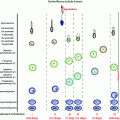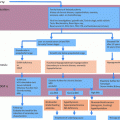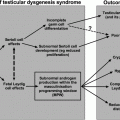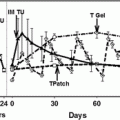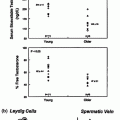Study
N
M/F
Inclusion criteria
Intervention
Co-intervention
Tx
Dur
Wks
Resp
Muscle Strength
Oxy
Pa02
Exercise
Capacity
(6MWT)
Body composition
Total
Muscle
Fat
Ferreira (1998)*
23
BMI < 20
PImax < 60%
T 250 mg IM once + St 12 mg qd
None* then
IMT then
ET
27
PImax ↔
FEV1 NR
NR
↔
↔
↔
↔
Schols (1995)a (depleted)
110?/?
iBW < 90%
ND IM
(50 mg M/25 mg F) q2wks
ET
8
PImax ↑
FEV1 ↔
NR
↔b
↑**
↑**
↓
Schols (1995)a (nondepleted)
107?/?
iBW ≥ 90%
ND IM
(50 mg M/25 mg F) q2wks
ET
8
PImax ↔
FEV1 ↔
NR
↔
↑**
↑**
↔
Creutzberg (2003)
63
BMI < 30
ND IM
50 mg q2wks
PR
8
PImax ↑
FEV1 NR
NR
NR
↔
↑
↔
Svartberg (2004)
29
BMI nml
T IM
250 mg
q4wks
None
26
PImax NR
FEV1 ↔
↔
↔
↔
↑
↓
Casaburi (2004)***
53
75–130% iBW
TE IM
100 mg
qwk
PRT
10
PImax ↔
FEV1 ↔
↑
NR
NR
↑
↓
Sharma (2008)
16 9/7
BMI normal
ND IM
(50 mg M/25 mg F) q2wks
PR
nutrition
ET
16
PImax ↔
FEV1 ↔
↔
↔
↔
↔
↔
Daga (2014)
32
BMI normal
ND IM
25 mg qwk
nutrition
6
PImax NR
FEV1 ↔
↔
↑
↔
NR
↑ arm circum
NR
Two studies are notable [15, 19]. The first, by Schols et al. examined 217 adults with stable, moderate to severe, and bronchodilator-unresponsive pulmonary disease, and randomized them to receive placebo injections, nutritional supplementation plus placebo injections, or nutritional supplementation plus nandrolone injections [15]. Randomization was stratified according to baseline muscle depletion (ideal body weight <90% with or without lean mass <67%) and all subjects underwent a rehabilitation program (9 week blocks of no co-intervention, inspiratory muscle training, and then exercise training successively). Both nutritional supplementation with or without nandrolone increased body weight compared to placebo, with combined therapy also increasing lean body mass in all individuals and respiratory muscle strength in depleted individuals. However, walking distance did not increase. In contrast, none of these parameters differed between those randomized to nutritional supplementation alone versus those who received nutritional supplementation plus nandrolone therapy. The lack of blinding with respect to the nutritional supplementation is a study limitation. After 4 years of follow-up, survival did not differ between those receiving nandrolone and nutritional supplementation, and either of the other two treatment groups [23]. One limitation of this study was that women were recruited, since the number, and whether there were gender differences in outcomes was not reported. The other study, from Casaburi et al. administered testosterone 100 mg or placebo every week to 47 male COPD patients, with or without progressive resistance training, 3 times each week for 10 weeks in a two-by-two factorial design, thereby allowing additive effects to be assessed [19]. Testosterone treatment was associated with a significant increase in body weight, increase in lean mass, and decrease in fat mass. Testosterone therapy with progressive resistance training (PRT) improved PaO2 relative to placebo therapy with resistance training, but this was not observed between those randomized to testosterone or placebo in those who were not randomized to resistance training. Subjects receiving testosterone and resistance training tended to have a greater increase in lean mass, but this was not statistically significant. A small and significant increase in peak oxygen uptake, peak work rate, and lactic acidosis threshold was observed only in the testosterone and resistance training group (compared with the no exercise and no testosterone group). Generally, however, the combination of testosterone with PRT was no better than either alone. This study provides some evidence that supplemental testosterone might be utilized together with rehabilitation programs to improve muscle strength and improve respiratory function in COPD patients.
In conclusion, the management of COPD should be multidisciplinary. Nutrition should be optimized and combined with cardiopulmonary rehabilitation. Testosterone therapy increases lean muscle mass, but this has not been demonstrated to translate into meaningful functional improvements thereby limiting widespread adoption. Further research in specific subgroups that are more likely to benefit from androgen therapy may be warranted.
Obstructive Sleep Apnea
Obstructive sleep apnea is associated with reduced blood testosterone, with lower blood testosterone concentrations being particularly related to greater degrees of hypoxemia [24]. The putative mechanisms underpinning reduced systemic testosterone exposure include hypoxemia-induced alterations in the hypothalamo-pituitary pulsatile secretion of luteinizing hormone [25–27], but detailed appraisal of the entire gonadal axis has not been systematically performed and direct testicular effects, from increased interleukin 2 or other factors, have not been excluded. Expert guidelines caution the use of androgen therapy in men with obstructive sleep apnea [28]. Two sets of two randomized controlled trials have examined the influence of testosterone therapy on sleep and/or breathing during sleep in young hypogonadal [29, 30] or older eugonadal men [31, 32]. In the first study [29], 11 hypogonadal men already receiving testosterone (testosterone enanthate 200–400 mg every two weeks) were studied, once approximately 3–7 (mean 3.5) days after a testosterone injection, and again at least 30 (mean 53) days after a testosterone injection in random order. Testosterone therapy increased the number of apneas and hypopneas by, on average, 9 events/h. In the other study [30], 10 men were rendered acutely hypogonadal with leuprolide, and were randomized to receive testosterone enanthate 200 mg or oil placebo every 2 weeks for 4 weeks. Testosterone only lengthened time in slow wave sleep, and effects on breathing were not reported.
In the other set of two studies performed in older eugonadal men, in the first study, 108 men were randomized to receive a dose-titrated testosterone patch (about 6 mg/day) or matching placebo for three years [31]. Sleep breathing did not deteriorate, but the portable device was relatively insensitive, could only detect hypoxemia but not breathing, and sleep architecture was not examined. In the other study [32], 17 older men were randomized to receive either three injections of intramuscular testosterone esters at weekly intervals (500, 250 and 250 mg) or matching oil-based placebo, and then crossed-over to the other treatment after eight weeks washout. Polysomnography occurred 2–4 days after the last injection. Testosterone shortened sleep by an hour, induced sleep disordered breathing by 7 events/h, and increased the duration of hypoxemia by 2%. These studies in men without sleep disordered breathing suggest that high dose testosterone esters, but not lower dose more steady-state testosterone therapy, may have short-term effects on sleep and disordered breathing.
Only one study has purposely treated men with obstructive sleep apnea with testosterone, utilizing the hypothesis that lower dose more steady-state therapy may have time-dependent effects on sleep disordered breathing [33–36]. Sixty-seven middle-aged obese men with obstructive sleep apnea were placed on a hypocaloric diet and randomized to additionally receive three intramuscular injections of either testosterone undecanoate 1000 mg or matching placebo every 6 weeks. Testosterone therapy worsened the oxygen desaturation index by 10 events/h and the duration of hypoxemia by 6% after the second injection, but not after the third [33]. These data are consistent with putative time-dependent effects where adaptations in the hyperoxic ventilatory recruitment threshold to carbon dioxide reduced the propensity to sleep disordered breathing with time [35]. Despite these adverse effects on breathing during sleep, 18 weeks of testosterone therapy increased muscle mass, reduced liver fat, and improved insulin sensitivity and sexual desire compared with placebo therapy [34, 36]. Further studies examining the risks and benefits of testosterone therapy in men with obstructive sleep apnea over the longer term are required.
Heart Diseases
Systolic Heart Failure
Blood testosterone concentrations are reduced in men with severe systolic heart failure or coronary artery disease (CAD) irrespective of etiology [37]. The mechanisms by which this occurs are multifactorial. Cardiopulmonary rehabilitation is a key component of the care of men with systolic heart failure [14], and androgen therapy could improve overall performance either directly, through increased skeletal muscle strength and cardiac contractility, or indirectly, through improved systemic oxygenation and blood flow. Five randomized placebo-controlled trials of 12–52 weeks of testosterone therapy are summarized in Table 19.2 [38–43]. All these studies, except Stout et al.’s [42], show that testosterone improves physical performance (walking). On the other hand, cardiac function (Left Ventricle Ejection Fraction) and biochemical markers of congestive cardiac failure (brain natriuretic peptide) are consistently unaffected by testosterone therapy. Accordingly, the improved physical performance is presumably secondary to direct skeletal muscle effects that are independent of changes in cardiac contractility. One methodological issue is that these walking tests are volitional, and hence can be altered by a placebo effect. Although all of these studies (Table 19.2) are placebo-controlled, only Malkin’s study utilized a matched placebo [40], with the remaining being possibly unblinded due to the use of a saline-based placebo [38, 39, 41–44]. Nevertheless, the unequivocally blinded study showed concordant findings [40], which were replicated in another unequivocally blinded trial of 36 women with CHF who were randomized to receive testosterone (300 μg) or placebo transdermal patch [45].
Table 19.2
CHF
Study | N M/F | Trial type | Intervention | Co-intervention | Duration (weeks) | Performance measure | Cardiac Function (LVEF) | Biochemical (BNP) |
|---|---|---|---|---|---|---|---|---|
Malkin (2003)/Pugh (2004) | 20 | PG | T* 100 mg IM q2wks | None | 12 | ISWT ↑ | ↔ | ↔ |
Malkin (2006) | 76 | PG | T patch 5 mg qd | None | 52 | ISWT ↑ | ↔ | ↔ |
Caminiti (2009) | 70 | PG | TU 1000 mg IM q6wks | None | 12 | 6MWT ↑ Muscle Peak Torque ↑ | ↔ | NR |
Schwartz (2011) | 58 | PG | TU 1000 mg IM q6wks | None | 12 | NR | NR | NR |
Stout (2012) | 41 | PG | T 100 mg IM q2wks | Exercise | 12 | ISWT ↔ | ↔ | ↔ |
Mirdamadi (2014) | 50 | PG | TE 250 mg IM q4wks | None | 12 | 6MWT ↑ | ↔ | NR |
The one study (by Stout et al.) which failed to show improved physical performance, was also the only study to select men with a low testosterone level (<15 nmol/L) and to concurrently enforce an exercise program consisting of aerobic and resistance training two times each week [42]. In this small study, the baseline shuttle walk distance of men randomized to receive testosterone was substantially lower than that of the placebo group, and 32% of subjects enrolled did not complete the study. Whether this really means that androgen therapy has no additional impact in men already undergoing an exercise program will require more and larger studies utilizing a two-by-two factorial design.
In addition to improvements in physical performance, two studies by Malkin et al. and Schwartz et al. have also shown beneficial electrocardiographic effects of testosterone therapy, namely on QT dispersion [38] and reduced QTc interval [41]. Both findings imply improved electrical conductance. Another study also examined immediate hemodynamic effects of testosterone therapy [46]. In this study, 12 men with CHF received 60 mg of buccal testosterone or matching placebo pills in random order on consecutive days. Testosterone therapy increased cardiac output measured by thermodilution, and reduced systemic vascular resistance 180 min after buccal application. Reduced systemic vascular resistance with testosterone therapy within this time frame is suggestive of peripheral arterial vasodilation. Whether the changes in cardiac output are real, or secondary to reduced vascular resistance, is not clear. Even if real, these immediate changes do not appear to be sustained. The most parsimonious interpretation of this study in conjunction with the studies shown in Table 19.2 would be that improvements in physical performance due to testosterone do not seem to be mediated by improved cardiac function.
Coronary Artery Disease
Three studies in men with coronary artery disease show that testosterone can rapidly improve cardiac ischemia (see Table 19.3) [47–49]. Improved cardiac ischemia within this timeframe is most consistent with coronary vasodilation, and this is consistent with animal studies which show that testosterone causes endothelium-independent coronary vasodilation through decreased smooth muscle tone. All studies were placebo-controlled, crossover in design, and objectively measured cardiac ischemia by stress ECG or imaging. Testosterone therapy improved cardiac ischemia in the first two studies by Rosano 1999 et al. and by Webb et a.l; these studies also discontinued anti-anginal therapy prior to enrolment and were performed 10 or 30 min after IV doses which raised testosterone concentrations up to 22-fold higher than normal [47, 48]. The third study by Thompson et al. was the largest, but did not show improved cardiac ischemia. In this study, anti-anginal therapy was not discontinued and dose titration occurred to carefully raise testosterone 2 and sixfold higher than baseline [49]. Whether the discordant findings relate to dose or concomitant medications requires further investigation. Nevertheless, only intravenous testosterone infusions that result in very high concentrations can acutely enhance brachial artery flow-mediated dilatation [50]. Not surprisingly, angina was not improved, likely owing to the short treatment duration.
Table 19.3
CAD
Study | N | Intervention | Design | Tx Dur | Washout Interval | Effect | Ischemia | Angina |
|---|---|---|---|---|---|---|---|---|
Rosano (1999) | 14 | T 2.5 mg IV once | XO | 5 min | 2 days | I | ↓ | ↔ |
Webb (1999) | 14 | T 2.3 mg IV once | XO | 10 min | 7 days | I | ↓ | ↔ |
Thompson (2002) | 32 | T IV Titrated | XO | 20 min | 7 days | I | ↔ | ↔ |
Jaffe (1977) | 50 | TC 200 mg IM qwk | PG | 8 weeks | S | ↓ | ↔ | |
Wu and Weng (1993) | 62 | TU 120 mg qd for 2wk then 40 mg qd for 2 wk | XO | 4 weeks | 14 days | S | ↓ | ↓ |
English (2000) | 46 | T patch 5 mg qd | PG | 12 weeks | S | ↓ | ↔* | |
Webb (2008) | 22 | TU 80 mg BID | XO | 8 weeks | None | S | ↓a | ↔ |
Cornoldi (2010) | 87 | TU 40 mg TID | PG | 12 weeks | S | ↓ | ↓ |
Five randomized placebo-controlled trials show that testosterone therapy for 1–3 months results in sustained improvements in measured cardiac ischemia (see Table 19.3) [51–55]. Wu’s and Cornoldi’s studies both report reduced angina [52, 55], and English’s study reports that perceived pain intensity, and physical role limitation measured by SF-36 questionnaire were improved by testosterone therapy [53]. These data, in combination with studies of immediate androgen action, suggest that improved cardiac ischemia can reduce symptoms when sustained. Blinding appeared to be adequate in all studies except possibly in one [52], in which another report inconsistently described the placebo treatment [56].
An unresolved issue is whether and how testosterone therapy would affect the process underlying coronary artery disease, and whether, over the longer term, such therapy would reduce, increase, or have no effect on cardiovascular events or mortality. Studies of androgen therapy of adequate duration in men with coronary artery disease are not available to address this issue, but data in men without coronary artery disease are available. In a study of 308 relatively healthy men over the age of 60, titrated testosterone gel therapy for 3 years did not increase common carotid artery intima media thickness or coronary calcification compared with placebo [57]. Although atherosclerosis progression was not demonstrated in this study that was adequately powered to do so, the possibility that effects may differ in those with preexisting or advanced atherosclerosis limits generalization to that population. Clinical trial data support this hypothesis. In one study that randomized 22 men to receive 8 weeks of testosterone undeconate 80 mg bid or placebo pills in random order, imaging studies showed increased myocardial perfusion only in areas supplied by unobstructed coronary arteries [54]. Nonrandomized observational studies of men without known coronary artery disease also report that testosterone therapy decreases [58], increases [59, 60] or does not change [61] cardiovascular events. Findings from randomized controlled trials are also contradictory [62, 63], with one study showing an excess of cardiovascular events [62], but not the other slightly larger study [63], despite both studies being nearly identical in study design. Meta-analyses of randomized placebo-controlled trials also show contradictory results [64, 65]. The first reported that testosterone therapy increases cardiovascular events [64], but a later meta-analysis that included more studies [65] did not.
In conclusion, testosterone therapy decreases cardiac ischemia and improves symptoms when sustained. Effects on the underlying atherosclerotic process are ill-defined, and concern remains regarding long-term effects on cardiovascular events and morbidity. Until the cardiovascular safety in otherwise healthy individuals is established, there does not appear to be a role for androgen therapy in those with coronary artery disease, given the many other treatment options that are disease modifying and/or anti-anginal.
HIV/AIDS
Hypogonadism is common in men with HIV especially in those with AIDS wasting. Testosterone production is adversely affected by HIV due to poor nutrition, opportunistic infections and the medications used to treat HIV/AIDS [66]. The availability of effective antiretroviral combinations has revolutionized the treatment and outcomes for patients with HIV/AIDS [67]. Both beginning therapy earlier, and effective preventative strategies, have reduced the progression of this disease so that wasting is much less common [68]. Randomized placebo-controlled trials of testosterone and the nonaromatizable androgens nandrolone, oxandrolone and oxymetholone are summarized in Tables 4 and 5, respectively [69–87]. These studies all showed that androgen therapy does not increase CD4 count or reduce viral load, except two studies showing either increased CD4 count [77] or reduced viral load [76], but not both. Nevertheless, androgen therapy for HIV/AIDS may still be useful to improve weight loss, weakness, mood, and quality of life. This is highly relevant because loss of fat-free mass [88], as well as cachexia in general [89], and specifically in those with HIV [90], predicts mortality. Accordingly, androgens or other agents such as megestrol or growth hormone that increase appetite and/or body weight may delay death, but no study has been designed to assess this outcome. Nevertheless, the degree of wasting may also be an important factor that modifies response.
Randomized placebo-controlled trials that examined the effect of testosterone, which is aromatizable (Table 19.4), or nonaromatizable androgens (Table 19.5) on weight, muscle mass, strength, and fat mass are summarized, showing wasting status. Most studies recruited men with wasting, and almost all studies recruited exclusively men, except two non-testosterone studies that included women [78, 85]. Three studies are not included due to design issues: one because it randomized between nandrolone alone with or without progressive resistance training [75], meaning that nandrolone alone effects could only be assessed within group, another because all subjects received megestrol, which is known to induce hypogonadism and may have confounded results [91], and the third because it only compared megestrol with oxandrolone [92]. Some studies of testosterone, and all studies of other androgens, recruited men with any baseline testosterone level, and even those that specified an upper testosterone value [70–72, 79, 86, 87] included men with total testosterone concentrations of up to 400 ng/dL. Irrespective of baseline testosterone and wasting status, androgen therapy increases muscle mass, and more consistently so with nonaromatizable androgens. In this regard, the two studies by Grinspoon are particularly notable because both assessed muscle comprehensively by three modalities (fat-free mass by DEXA, lean mass by total body potassium and muscle mass by urinary creatinine excretion), and all three measures were increased by 6 months of testosterone therapy compared with placebo [71, 76]. Furthermore, these changes were sustained during the 6-month open-label extension of the study [93]. Two studies by Grinspoon 2000 and Bhasin 2000 of testosterone therapy have additionally examined specific peripheral muscle area [76, 79]. Both show an increase in CT or MRI measured leg and/or arm muscle area.
Table 19.4
HIV aromatizable androgens
Study | N | T status (ng/dL) | Wasting (Y/N) | Androgen intervention | Co-intervention | Weeks | Strength | Body Composition | Biochem | ||
|---|---|---|---|---|---|---|---|---|---|---|---|
Total | muscle | fat | |||||||||
Coodley (1997)** | 39 | Any | Y WL > 5% | TC 200 mg IM q2wk | None | 12 | ↔ | ↔ | NR | NR | CD4 ↔ Viral NR |
Bhasin (1998) | 41 | <400 | N | T patch 5 mg qd | None | 12 | UE ↔ LE ↔ | ↔ | ↔ | ↓ | CD4 ↔ Viral ↔ |
Grinspoon (1998) | 51 | Anya | Y iBW < 90% ± WL > 10% | TE 300 mg IM q3wk | None | 24 | 6MWT ↔ | ↔ | ↑ | ↔ | CD4 ↔ Viral ↔ |
Dobs (1999) | 133 | <400b | Y WL 5-20% | T scrotal patch 6 mg qd | None | 12 | NR | ↔ | NR | NR | CD4 ↔ Viral ↔ |
Bhasin (2000) | 61 | <350 | Y WL ≥ 5% | TE 200 mg IM qwk | PRT thrice weekly* | 16 | UE ↔ LE ↔ | ↑ | ↔ Thigh (MRI) ↑ | ↔ | CD4 ↔ Viral ↔ |
Grinspoon (2000) | 54 | Any | Y iBW < 90% ± WL > 10% | TE 200 mg IM qwk | PRT thrice weekly* | 12 | UE ↑ LE ↔ | ↑ | ↑ arm (CT) ↑ leg (CT) ↑ | ↓ | CD4 ↔ Viral ↓ |
Bhasin (2007) | 88 | <400c | N Abdominal obesity | T 1% gel 10 g qd | None | 24 | NR | ↔ | ↑ | ↓ | CD4 ↔ Viral ↔ |
Knapp (2008) | 61 | <400 | Y BMI < 20 ± WL ≥ 5% | TE 300 mg IM qwk | None | 16 | LE ↔ Physical function ↔ | ↔ | ↑ | ↔ | CD4 ↔ Viral ↔ |
Sardar (2010) | 104 | Any | Y BMI < 20 ±WL 5–10% | ND 150 mg IM or T 250 mg IM q2wk (2:2:1) | None | 12 | NR | ↑ | NR | ↔ | CD4 ↔ Viral NR |
Table 19.5
HIV nonaromatizable androgens
Study | N M/F | T status | Wasting (Y/N) | Androgen Intervention | Co-intervention | Duration (weeks) | Strength | Body Composition | Biochem | ||
|---|---|---|---|---|---|---|---|---|---|---|---|
Total | Muscle | Fat | |||||||||
Berger (1996) | 63 | Any | Y WL ≥ 10% | Ox 5 mg or 15 mg qd | None | 16 | ↔ | ↑ | NR | NR | CD4 ↑ Viral NR |
Strawford (1999) | 24 | >225 | Y WL ≥ 5% | Ox 20 mg qd | PRT + T 100 mg qwk | 8 | UE ↑ LE ↔ | ↑ | ↑ | ↔ | CD4 ↔ Viral ↔ |
Batterham (2001)a | 15 | Any | Y WL ≥ 5% | ND 100 mg IM q2wk
Stay updated, free articles. Join our Telegram channel
Full access? Get Clinical Tree
 Get Clinical Tree app for offline access
Get Clinical Tree app for offline access

| |||||||
